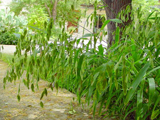Native Plants

Q. Who is Mr. Smarty Plants?
A: There are those who suspect Wildflower Center volunteers are the culpable and capable culprits. Yet, others think staff members play some, albeit small, role. You can torture us with your plant questions, but we will never reveal the Green Guru's secret identity.
Did you know you can access the Native Plant Information Network with your web-enabled smartphone?
Ask Mr. Smarty Plants is a free service provided by the staff and volunteers at the Lady Bird Johnson Wildflower Center.

rate this answer
Friday - April 09, 2010
From: College Station, TX
Region: Southwest
Topic: Grasses or Grass-like
Title: Arguments for planting native grasses in College Station TX
Answered by: Barbara Medford
QUESTION:
I hear big ads about putting zoysia grass on my urban lawn but I would rather plant native grass, like Texas Bluegrass (for shady areas) and Blue Grama and Buffalograss grasses. What arguments can I give my husband to win him over to the native grasses and not the zoysia grass?ANSWER:
We applaud your purpose, but may have bad news about the shade tolerance of Poa arachnifera (Texas bluegrass). Here are the Growing Conditions from our Native Plant Database:
"Water Use: Medium
Light Requirement: Sun , Part Shade
Soil Moisture: Moist
Soil Description: Loams. Sandy, Sandy Loam, Medium Loam, Clay Loam, Clay
Conditions Comments: This Texas cool season native forms clumps with narrow blue-green leaves. In spring the showy 2-3 ft. fluffy silvery flowers rise above the foliage. Good in most well drained soils. Can tolerate some shade. A good groundcover unmowed or mowed. Unlike most grasses, male and female flowers are borne on separate plants."
We consider "part shade" to be 2 to 6 hours of sun daily, and the line in the Comments "can tolerate some shade" leads us to believe that the part shade would need to be on the high end of that 2-6 hours of sun. So, what you have to ask yourself, as you look at the areas in question, how shady is shady? In this article on Zoysiagrass, by Richard L. Duble, Turfgrass Specialist, Texas Cooperative Extension, we found this information: "In the southern U.S., the zoysiagrasses grow well in moderately shaded locations." So, we're back to Square One; what is "moderately" shaded?
If you would like to stick to natives, and we hope you do, perhaps you should find some other options for the "part shade" or "moderately shaded" locations, like more shade-tolerant grasses that are attractive and do not have to be mowed. Some of them require low watering, like the Texas Bluegrass and unlike the Zoysiagrass. Some are attractive year round, provide shelter and nesting materials for birds and just need some mulch around their roots to make them pretty low-maintenance. We're going to list a few of those that we think would work in your situation; follow each plant link to our webpage on that particular plant to learn more about it. We will go to our Recommended Species section, select Central Texas on the map, grasses or grass-like plants under General Appearance, and part shade or shade under Light Requirements. You can repeat this search to look for other choices.
Grasses or Grass-like Plants for Part Shade in Central Texas:
Andropogon gerardii (big bluestem) - 4 to 8 ft. tall, low water use, sun or part shade
Bouteloua curtipendula (sideoats grama) - State Grass of Texas, medium water use, sun or part shade
Chasmanthium latifolium (Inland sea oats) - 2 to 4 ft., medium water use, part shade or shade
Bouteloua hirsuta (hairy grama) - 10 to 18 in., low water use, part shade
Nolina texana (Texas sacahuista) - 1 to 3 ft., low water use, part shade
Schizachyrium scoparium (little bluestem) - 18 to 24 in., low water use, sun or part shade
Sorghastrum nutans (Indiangrass) - 3 to 8 ft., medium water use, sun, part shade or shade
Tripsacum dactyloides (eastern gamagrass) - 2 to 3 ft., high water use, part shade
From our Native Plant Image Gallery:
More Grasses or Grass-like Questions
Making sod from native grass seeds from Pflugerville TX
April 28, 2012 - I am trying to install a native lawn. A story on KVUE suggested 2 lb Buffalo, 1.5 lb Blue Grama, and 6 oz of Curly Mesquite.
I have some seeds purchased from seedsource.com about 2 years ago. I can...
view the full question and answer
Bunch grasses for labyrinth that are good for livestock
September 29, 2013 - Dear Mr. Smarty Plants,
I'm designing an outdoor labyrinth that will be in full sun in our black Slidell clay soil here in north central Texas. The area MAY be mowed for hay at a later date (i.e...
view the full question and answer
Erosion Control for a Shaded Slope in Aliquippa PA
May 07, 2014 - What plants. shrubs or trees can I plant to retard soil erosion on a steep shaded hillside in PA
view the full question and answer
Time to Plant Blue Grama Seeds in Spring Branch, Texas
June 11, 2011 - We would like to plant Blue Grama grass seeds but due to the hot weather with no rain here in central Texas, can we wait until September or even October to plant grass seeds? Thank you
view the full question and answer
Plants for slope in central Alabama
July 26, 2011 - Our home is atop a 20-25' eastern facing sandy loam slope in central Alabama. It was previously covered w/ kudzu. After 3 yrs. of eradication of the kudzu we are ready to plant with native grasses/pl...
view the full question and answer
| Support the Wildflower Center by Donating Online or Becoming a Member today. |

